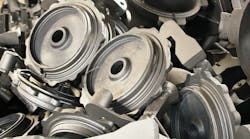With the U.S. Congress now considering cap-and-trade legislation to reduce the country’s carbon and other greenhouse gas (GHG) emissions, we need to find a way to address the climate issue while keeping energy prices affordable for families and energy-intensive industries such as the metalcasting industry. Our industry has developed a framework that we believe can help guide U.S. climate policy in achieving both goals.
The framework calls for lowering the nation’s GHG emissions by 80% from current levels by 2050. And it includes protections that can soften electricity price increases for families and our energy-intensive customers such as the metalcasting industry. Key among them is the allocation of emissions allowances.
Under a cap-and-trade program, the federal government would set a national limit, or cap, on GHG emissions. Over time, this cap would be lowered until the ultimate GHG reduction goal is met. Electric utilities, manufacturers, and other emitters would either receive or purchase allowances (one allowance equals one ton of carbon emissions) in order to emit GHG emissions under the cap.
Then, each year companies would have to surrender emissions allowances in an amount equal to the carbon and other GHG emissions they emit. As the program progresses, the government would reduce the overall number of allowances, thereby compelling more and more emission reductions.
The method by which the government initially introduces the allowances into the market—by auction or allocation—is crucial. Congress could require businesses to purchase allowances from the federal government at auction, or it could allocate allowances directly to them.
If allowances were allocated, only the costs of actually reducing emissions would be passed along to consumers. This is important for keeping energy costs down. In contrast, auctioning allowances would sharply increase energy costs because companies would have to pay for both the allowances and for the cost of actually reducing their emissions. All of these costs would be passed on to consumers.
A portion of the revenue raised through a government auction may be returned to consumers via a tax rebate. But, this isn’t an efficient mechanism for channeling relief to energyintensive industries. And, it’s very likely that much of the revenue raised could be directed to programs completely unrelated to mitigating higher energy prices or developing the technologies that as a nation we need to transition to a vibrant, low-carbon economy.
Support is growing for allocating allowances as an important transition mechanism. The U.S. Climate Action Partnership—an alliance of major businesses such as Alcoa, DuPont, and General Electric, as well as leading climate and environmental groups—is in favor of allocating emissions allowances. So is the Pew Center on Global Climate Change, the National Association of Regulatory Utility Commissioners, and a number of labor groups, among others.
Protecting consumers from energy price shocks, while cutting carbon emissions, will certainly take other measures besides allocating emission allowances. One safeguard would be putting a collar on the price of carbon—imposing both a firm floor and a firm ceiling on the price that a regulated facility would pay for emissions allowances. This collar should start out narrow, and then gradually expand as more ‘climatefriendly’ technologies become available.
Another safeguard we’re recommending is for companies to be able to reduce a portion of their GHG emissions through offsets: cost-effective activities such as planting trees and capturing methane from landfills.
The need for new, advanced technologies to move to a ‘smart,’ low-carbon economy can’t be overstated. We, in partnership with the government and others, already are developing and putting them to use.
In the near term, we’re doing more with energy efficiency and renewables. Our efficiency programs already are helping consumers and businesses reduce their electricity use. And, we’re taking steps to expand the impact of these programs. We’re also working with a number of allies to make the nation’s building codes and appliance standards more energy efficient.
And we’re generating more electricity from renewable energy sources. Although non-hydro renewables generated just 3% of the nation’s electricity last year, they accounted for almost two-thirds of all new power-plant announcements. And last year, for the first time, the industry added almost as much renewable energy capacity as it did natural-gas capacity. The recently enacted stimulus package will help to boost the use of renewables with its long-term extension of the production tax credit for wind and other renewable energy sources.
Given that regions with great potential for wind generation usually are located far from the urban areas where the electricity is needed, we’re also working to connect the two better by reinforcing and expanding the nation’s transmission system. And we’re making the grid “smarter” by turning it into a two-way highway so that information and electricity can flow back and forth between electric utilities and their customers. Among other features, this will enable utilities to use meters and rates that reflect the price of electricity as it changes throughout the day. Increasing price sensitivity can help to narrow peak-demand periods, which will save consumers money and lead to lower carbon emissions.
Plug-in hybrid electric vehicles (PHEVs) and ‘pure’ electric vehicles can help to lower carbon emissions in the near term as well. These technologies can reduce the country’s dependence on foreign oil, too, improve air quality, and save consumers money at the pump. Many EEI member companies are working now with the auto industry to get PHEVs on the road.
For the mid-to-longer term, we’re developing advanced nuclear and coal power plants. The nuclear energy industry, which generates about 20% of the nation’s electricity, is experiencing a rebirth, with a number of applications for new units filed last year.
Coal, because of its low cost and domestic abundance, generates about half the country’s electricity today. The industry is developing more efficient and more environmentally friendly power plants to use coal. We’re also working aggressively to develop and eventually deploy technologies that can capture and store their carbon emissions.
These advanced coal technologies, while still years away from large-scale deployment, hold great promise, and will be essential to meeting global environmental goals. Coal is a major source of electricity generation not only in the U.S., but in other parts of the world as well, including China and India.
Under any scenario, making dramatic reductions in our country’s carbon emissions will be expensive. But, by including economic safeguards—especially the allocation of emissions allowances—we can lessen energy cost increases under a national climate-change program











